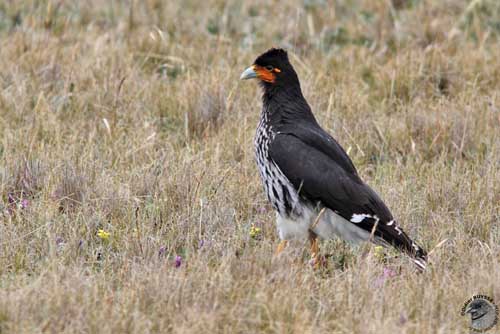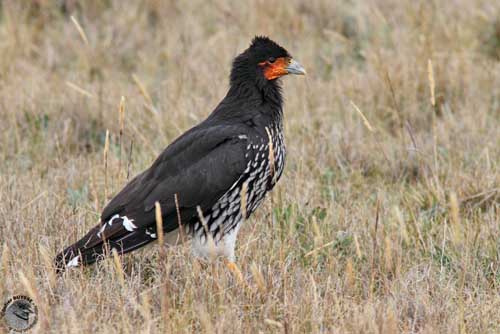
Fr: Caracara caronculé
All : Streifenkarakara
Esp : Caracara Carunculado
Spanish (Colombia): Caracara Paramuno
Ital : Caracara caruncolato
Nd: Lelcaracara
Sd: Knölcaracara
Photographer:
Didier Buysse
Vision d’Oiseaux
Text by Nicole Bouglouan
Sources:
HANDBOOK OF THE BIRDS OF THE WORLD Vol 2 by Josep del Hoyo-Andrew Elliot-Jordi Sargatal - Lynx Edicions - ISBN: 8487334156
A GUIDE TO THE BIRDS OF COLOMBIA by Steven L. Hilty and William L. Brown - Princeton University Press – ISBN 069108372X
BirdLife International (BirdLife International)
Global Raptor Information Network - Working to Conserve Birds of Prey in nature
Carunculated Caracara
Phalcoboenus carunculatus
Falconiforme Order – Falconidae Family
BIOMETRICS:
Length: 50-56 cm
Wingspan: 110-115 cm
DESCRIPTION:
The Carunculated Caracara is an opportunistic species usually seen walking on the ground in open habitats in the high Andes. It is very similar to the Mountain caracara (P. megalopterus), but this one has uniform black chest and upper belly.
The adult has glossy black head, neck and upperparts. On the black upperwing, the flight feathers are tipped white, forming a white trailing edge.
The uppertail-coverts are black, whereas the black tail has conspicuous white base and terminal band.

On the underparts, black breast and upper belly are broadly streaked white. Lower belly, undertail-coverts and thighs are white. On the underwing, wing-coverts and bases of flight feathers are white.
On the head, the black crown shows a moderately curled crest. The bare skin of face, cere, eyering and throat is bright orange-red to deep red. On the throat, the wrinkled skin forms wattles.
The bill is whitish. The eyes are brown to blackish-grey. Long legs and feet are bright yellow.
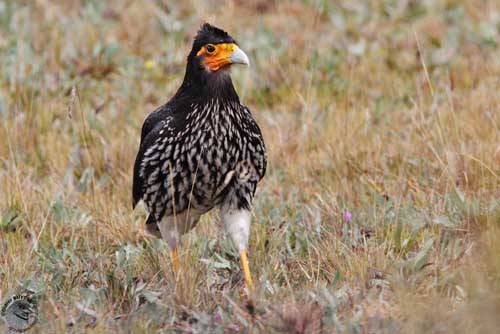
Both sexes are similar.
The immature is fuscous-brown above with blackish-brown shaft streaking. Head, rump and underparts show weak white mottling. The tail has narrow white terminal band.
The bare face is dull yellow. The bill is grey. Legs and feet are dusky.
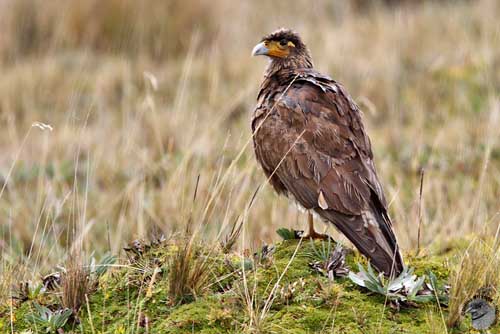
VOICE: SOUNDS BY XENO-CANTO
The Carunculated Caracara utters raucous territorial calls while throwing the head back, almost touching the shoulders. But at nest, they give short clicks and grumbles if disturbed.
HABITAT:
The Carunculated Caracara frequents the páramo (high, tropical, montane vegetation), the grassy pastures with some bushes, and the open areas at high elevation, up to 3000-4000 metres, where it can be seen walking in dry treeless highlands.
RANGE:
The Carunculated Caracara is found above the tree-line in the Andes of Ecuador and SW Colombia.
BEHAVIOUR:
The Carunculated Caracara often occurs around cattle in grassy pastures. This species feeds on carrion, but also takes numerous living preys such as worms, insects, amphibians, lizards, small rodents and birds.
It walks and runs on the ground, often foraging in family groups of 7-8 birds, but also in larger flocks of up to 40 around cattle, and scavenging almost anything they can find and eat.
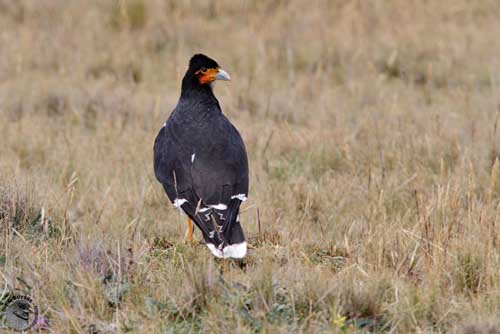
At the beginning of the breeding season, the bare face becomes brighter. The birds give territorial calls while throwing their head back. Some circular flights can be observed high in the air.
This species is probably sedentary. Large flocks of up to 100 birds and more can be seen outside the breeding season.
FLIGHT:
The Carunculated Caracara has strong flight and often soars even into strong winds. It may soar over great distance on half-closed wings.
It also performs low flight when searching for preys.
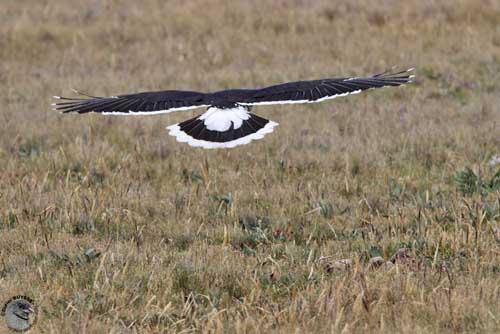
REPRODUCTION:
The Carunculated Caracaras nest on cliff-ledges where they build a structure with sticks. It may occasionally nest in tree.
The female usually lays 2 eggs in September-October. The young fledge in January.
The nesting behaviour of this species is poorly known.
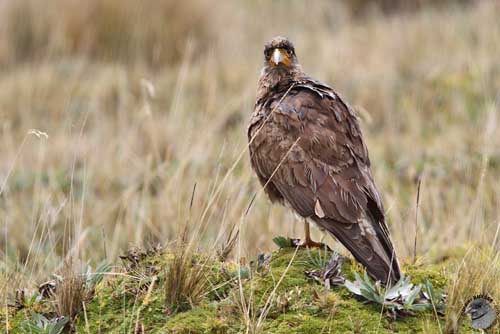
DIET:
The diet of the Carunculated Caracara can be different according to the area, and changes from a mountain to another. But it usually feeds on numerous food items such as carrion, earthworms, insects, amphibians, lizards, small birds and small mammals (including young rabbits). It may also take some plant matter.
It forages by walking and running about on the ground, and sometimes by flying low from the ground.
This species replaces crown and ravens at high elevations.
PROTECTION / THREATS / STATUS:
The Carunculated Caracara is uncommon to locally fairly common in highlands and grassy pastures. It is relatively common near the border with Ecuador, and is spreading its range in some parts of the habitat.
The species is not currently threatened.
